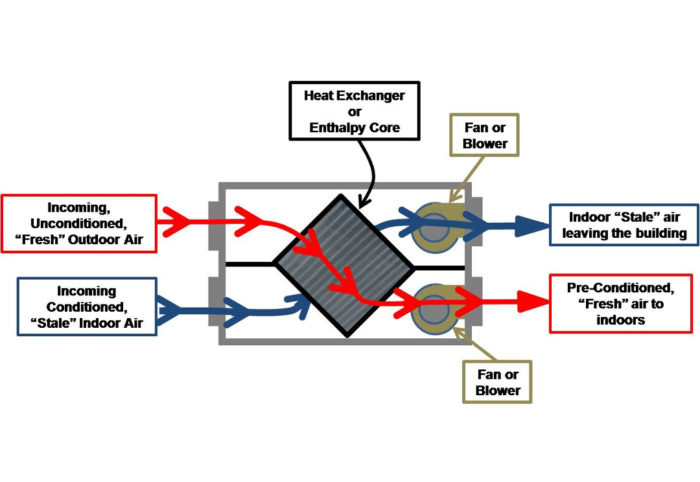How HRV Delivers a Cleaner Indoor Living Environment
Wiki Article
The All-Inclusive Overview to the Uses of Heat Recovery Ventilation in Modern Buildings
Heat Recovery Ventilation (HRV) systems represent a substantial development in developing modern technology (HRV Heat Recovery Ventilation). They offer a technique for exchanging stagnant indoor air with fresh outdoor air while reducing energy loss. This method not just enhances indoor air quality yet additionally contributes to power efficiency in both household and business structures. Understanding the different applications and benefits of HRV can disclose its essential duty in modern-day style and sustainability initiatives. The effects of this innovation are worth discovering additionallyUnderstanding Heat Recovery Ventilation Systems

Numerous modern-day buildings focus on power efficiency, comprehending heat recuperation ventilation (HRV) systems is crucial for enhancing indoor air top quality and minimizing energy intake. HRV systems work by moving warm from stale indoor air to inbound fresh air, effectively preserving comfy interior temperatures while lessening power loss. These systems consist of a heat exchanger, followers, and ductwork that help with the flow of air. During wintertime, HRV devices record and recycle warm from the outbound air, while in summer, they can assist cool inbound air. By continuously trading air, HRV systems also minimize humidity and the concentration of indoor pollutants. Correct installation and upkeep of HRV systems are essential for their effectiveness and efficiency in boosting general structure efficiency and convenience.
Benefits of Heat Recovery Ventilation
Heat recovery ventilation systems use numerous advantages that boost both power effectiveness and indoor air quality in modern-day structures. By capturing and recycling power from exhaust air, these systems considerably decrease home heating and air conditioning prices, resulting in lower power intake. They keep a consistent flow of fresh exterior air, lessening the risk of indoor air toxins and allergens. This continual exchange helps control moisture degrees, preventing mold and mildew development and ensuring a healthier living atmosphere. Furthermore, HRV systems add to sustainability goals by lowering overall carbon footprints. Their capability to enhance ventilation without compromising thermal convenience makes them a valuable addition to contemporary structure design, advertising both financial and environmental advantages.Applications of HRV in Residential Structures
As house owners increasingly focus on energy performance and interior air top quality, the applications of warmth recovery air flow (HRV) systems in residential structures have actually ended up being extra widespread. HRV systems are especially advantageous in tightly secured homes, where preserving fresh air blood circulation is vital for protecting against moisture buildup and indoor contaminants. They successfully move heat from outbound stale air to inbound fresh air, decreasing energy prices related to heating and cooling. In addition, HRVs can boost convenience levels by managing moisture and temperature. They are likewise adaptable for different domestic layouts, including single-family homes and multi-unit structures. Generally, integrating HRV systems supports sustainable living techniques while making sure a much healthier interior setting for residents.HRV in Industrial and Industrial Settings
In business and commercial settings, the application of warm healing ventilation (HRV) systems has become significantly essential for maximizing energy performance and preserving air top quality. These systems efficiently transfer warmth from exhaust air to inbound fresh air, lowering the requirement for additional heating or air conditioning. This not only reduces energy costs but also adds to sustainability initiatives. Industries such as production, warehousing, and HRV Heat Recovery Ventilation workplace buildings benefit substantially from HRV systems, as they aid control temperature level and humidity degrees, making certain a comfortable and efficient atmosphere. HRV systems help in removing impurities and excess dampness, enhancing indoor air high quality. As policies around air top quality become more stringent, the adoption of HRV modern technology is likely to grow, making it an essential part of modern-day commercial and commercial infrastructure.Future Trends in Heat Recovery Ventilation Innovation

Regularly Asked Questions
Just How Does Heat Recovery Ventilation Influence Indoor Air Top Quality?
Heat recovery ventilation significantly improves indoor air high quality by constantly exchanging stale interior air with fresh outside air while recouping energy. This procedure reduces contaminants, maintains perfect humidity levels, and guarantees a healthier environment for occupants.Can HRV Equipments Be Installed in Existing Buildings?
HRV systems can without a doubt be set up in existing buildings. Retrofitting may call for modifications to ductwork and air flow formats, yet it substantially enhances energy performance and interior air high quality, making it a practical option for older frameworks.What Maintenance Is Required for HRV Systems?

Exist Details Climates Where HRV Is Extra Effective?
Heat recovery ventilation systems are particularly effective in climates with considerable temperature distinctions between seasons. These systems maximize energy effectiveness by recuperating heat from exhaust air, making them suitable for both cool and reasonably cozy atmospheres.Just How Do HRV Solutions Affect Energy Expenses?

Report this wiki page